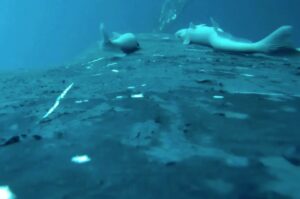In the deep sea, anglerfish reign supreme. These demons of the black abyss prowl down to 4,000m, tricking unsuspecting prey with bioluminescent tactics. Their otherworldly appearance — abnormally large head, sharp, glassy teeth, clouded eyes, and a luminescent antenna or fishing rod — are the stuff of nightmares. One researcher likened them to a “satanic potato”. What is even more remarkable is the way they mate.
The dating prospects for the 170 known species of anglerfish are somewhat poor. Marine life is hardly abundant this deep in the Abyssopelagic Zone. There is no light, a pressure of over 5,850 pounds per square inch, frigid temperatures of 2°C, and extremely low oxygen levels. This zone covers 60% of the Earth’s surface.
So, living creatures, especially mates, are hard to come by. Which is why when two lucky anglerfish do manage to cross paths, they hold on to each other for dear life…literally.
A toxic relationship
The anglerfish you see in pictures are usually pretty females. The male, several times smaller, measures less than a centimeter. The odd sex lives of anglerfish first gained attention in the 1920s, in the work of ichthyologists Charles Tate Regan and Bjarni Saemundsson. At first, they mistook the males for baby anglerfish or larvae. Eventually, they figured out that this was actually an example of sexual dimorphism, with smaller males and much larger females, like spiders.

A fanfin seadevil mating. Photo: Rebikoff Foundation
After certain species of anglerfishes mate, the pair don’t just go their separate ways. Rather, they fuse together for the rest of their lives. Depending on the species, a male has special receptors that alert him to nearby females of his own species. When he finds her, he will bite into her and remain attached to her head, belly, near her tail, or other accessible spots.
His tiny mouth dissolves into the female’s skin, and essentially the two become one. In the process, the female gains his cells, DNA, and reproductive organs. Meanwhile, the male becomes what is called a sexual parasite of the female.
Theodore Pietsch, who researched anglerfish behavior extensively, wrote that the poor male is “merely an appendage of the female and entirely dependent on her for nutrition.”
He draws this nutrition from her blood. A female can carry up to eight mates at a time, attached to various parts of her body. For species like the footballfish, stargazing seadevil, and triplewart seadevil, this is a permanent set-up.
Dismantling its immune system for love
A recent study found that this lifelong parasitic relationship has some evolutionary consequences. This permanent fusion between the sexes led to drastic genetic and anatomical changes in the female. The female anglerfish basically sheds her immune response cells (T cells) and key antibodies to accommodate her mate.
Riley Black of National Geographic writes that sexual parasites are “more susceptible to disease and abnormalities in a mutational meltdown.” This begs the question: How can anglerfish withstand infections and disease?

Another species of anglerfish with two males attached. Photo: VCG
Evidence shows that anglerfish might have a backup immune system or undiscovered innate abilities to account for this loss. Scientists have never seen such extreme forms of evolution and adaption before. Species that attach temporarily do not elicit such responses. Rather, when the male attaches itself for a short time, it triggers only a small reduction in antibodies.
Why is this important?
Sexual parasitism occurs in some other fish, including Amazon Mollies, although in a different way. The female uses the male’s sperm to create offspring that are clones of herself. Meanwhile, the male’s genetic legacy is completely lost. Still, this is nowhere near as extreme as the anglerfish.
Scientists remain unsure why this takes place. Did the scarcity of mates in those dark depths force anglerfish to evolve to the point of discarding their immune systems?
If scientists can pin down the mechanics of this extraordinary ability, it could help humans suffering from immune deficits.






